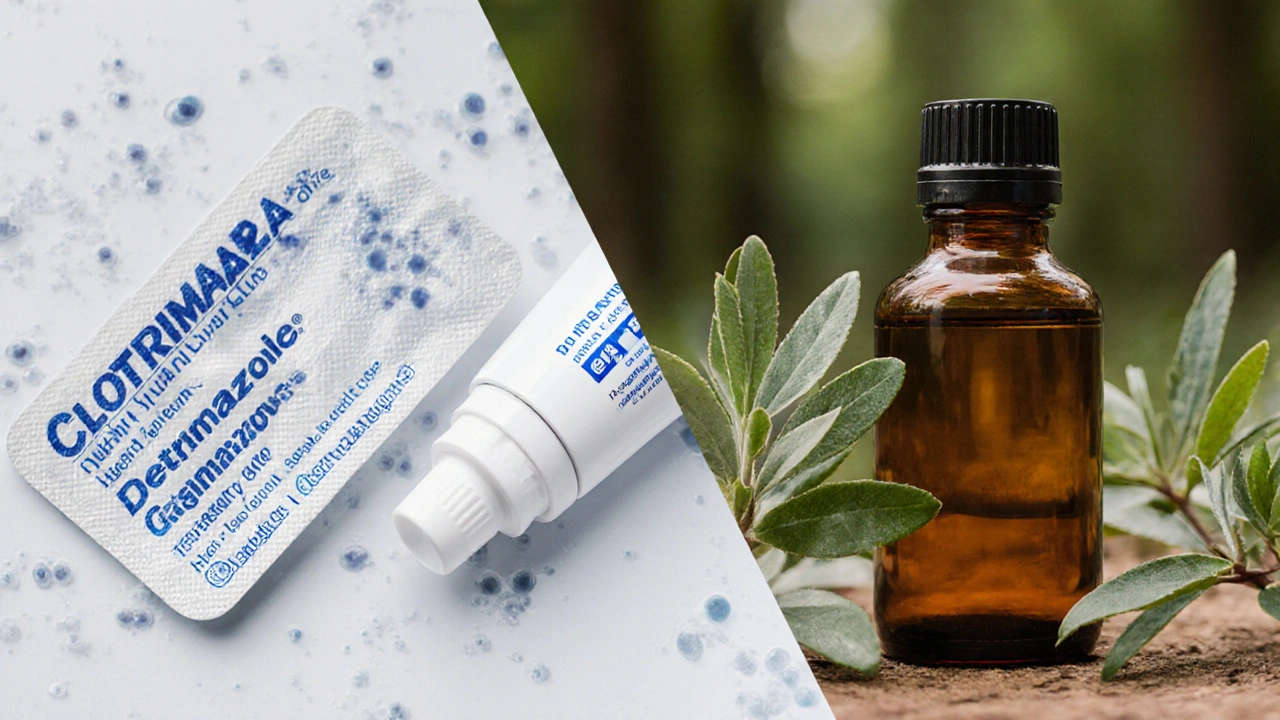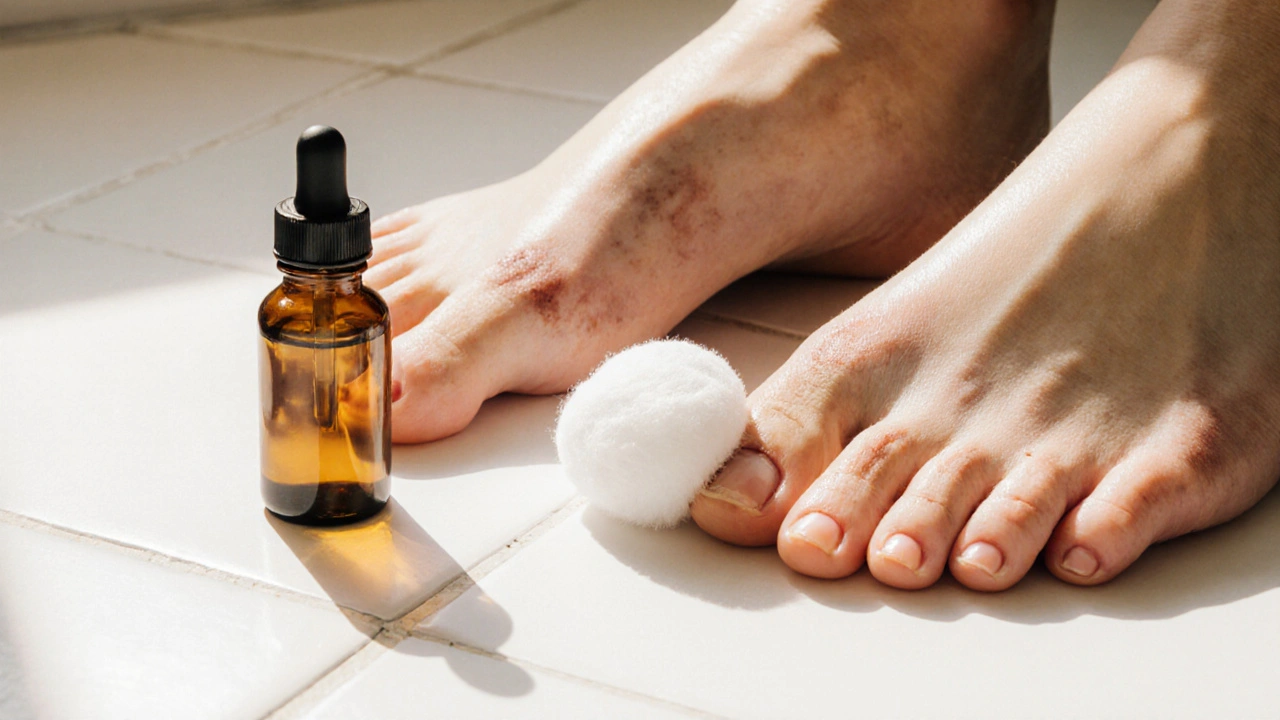Tea Tree Oil is a steam‑distilled essential oil extracted from the leaves of Melaleuca alternifolia, an Australian native tree that offers strong antifungal, antibacterial, and anti‑inflammatory properties. It has become a popular natural remedy for athlete's foot, medically known as tinea pedis.
If you’ve ever dealt with itching, burning, or flaky skin between your toes, you know how annoying athlete’s foot can be. Conventional creams work, but many people look for a gentler, plant‑based option that won’t disrupt the skin’s natural balance. Below we break down why tea tree oil is worth a spot in your foot‑care cabinet, how to use it safely, and how it stacks up against over‑the‑counter antifungals.
Understanding Athlete’s Foot
Athlete's foot is a fungal infection caused primarily by the dermatophyte Trichophyton rubrum. The fungus thrives in warm, moist environments-think sweaty gym socks, communal showers, or damp shoes. Symptoms typically begin with itching, then progress to redness, scaling, and sometimes painful cracks.
Why Tea Tree Oil Targets the Fungus
The star of the show is Terpinen‑4‑ol, a sesquiterpene alcohol that makes up 30‑40% of tea tree oil’s composition. Scientific studies from the University of Queensland (2022) show terpinen‑4‑ol disrupts the fungal cell membrane, causing leakage of intracellular material and ultimately cell death. This mechanism mirrors that of synthetic antifungals but without the harsh chemicals.
Beyond terpinen‑4‑ol, the oil contains γ‑terpinene and α‑terpinene, which add to the broad‑spectrum antifungal activity. The result is a natural, multi‑component attack that reduces the chance of the fungus developing resistance.
Key Benefits of Tea Tree Oil for Athlete’s Foot
- Antifungal potency: In‑vitro tests report a minimum inhibitory concentration (MIC) as low as 0.05% for tinea pedis isolates.
- Anti‑inflammatory effect: Reduces redness and itching by inhibiting prostaglandin synthesis, offering faster symptom relief.
- Low systemic toxicity: When diluted correctly, it stays on the skin without entering the bloodstream in harmful amounts.
- Preserves skin microbiome: Unlike broad‑spectrum drugs that wipe out beneficial bacteria, tea tree oil targets the pathogen while sparing commensal microbes.
- Cost‑effective: A 10ml bottle (≈30drops) lasts for several months of twice‑daily applications.
How to Apply Tea Tree Oil Safely
- Patch test first: Apply 1‑2 drops of undiluted oil onto the inner forearm, cover, and wait 24hours. If no redness or irritation appears, you’re good to go.
- Dilution ratio: Mix 3drops of tea tree oil with 1teaspoon (5ml) of a carrier such as coconut oil, jojoba oil, or an unscented moisturizer. This brings the concentration to roughly 1%-the sweet spot for antifungal action without irritation.
- Clean the area: Wash feet with mild soap, dry thoroughly (especially between toes), and apply the diluted mixture using a cotton ball.
- Frequency: Treat twice daily (morning and night) for 2‑4weeks. Continue for another week after symptoms disappear to prevent recurrence.
- Complementary care: Keep shoes breathable, rotate socks daily, and consider using an antifungal foot powder.

Comparison: Tea Tree Oil vs. Conventional Antifungals
| Attribute | Tea Tree Oil | Clotrimazole | Miconazole |
|---|---|---|---|
| Active ingredient | Terpinen‑4‑ol (30‑40% of oil) | Clotrimazole (1% cream) | Miconazole nitrate (2% cream) |
| Mechanism | Disrupts fungal cell membrane | Inhibits ergosterol synthesis | Blocks sterol production |
| Onset of relief | 2‑3days (anti‑inflammatory) | 5‑7days | 5‑7days |
| Side‑effects | Rare irritation if undiluted | Possible burning, rash | Possible dermatitis |
| Cost (per treatment) | ≈$10 for 30days | ≈$15 for 30days | ≈$12 for 30days |
Safety Tips & Common Pitfalls
While tea tree oil is generally safe, a few missteps can turn a miracle into a mess.
- Don’t apply undiluted on sensitive skin: Direct application can cause contact dermatitis, especially on cracked skin.
- Avoid ingestion: The oil is for topical use only; swallowing can cause gastrointestinal upset.
- Store properly: Keep the bottle in a dark, cool place to prevent oxidation that reduces potency.
- Check for allergies: People allergic to other essential oils (e.g., eucalyptus) may react to tea tree oil.
- Watch for drug interactions: If you’re using prescription antifungals, discuss with a dermatologist to avoid over‑dosage.
Integrating Tea Tree Oil Into a Holistic Foot Care Routine
Think of tea tree oil as one piece of a broader wellness puzzle. Pair it with these habits for the best odds of staying fungus‑free:
- Wear moisture‑wicking socks made of wool or synthetic blends.
- Rotate shoes every 24hours and let them air out.
- Use a foot scrub (e.g., oatmeal + lemon) once a week to remove dead skin.
- Apply a light layer of non‑comedogenic moisturizer after the oil has dried to keep the skin barrier intact.
- Schedule an annual check‑up with a dermatologist if you have recurrent infections.
Bottom Line
Tea tree oil offers a scientifically backed, low‑cost, and skin‑friendly alternative to synthetic antifungal creams. When diluted correctly and used consistently, it can clear up athlete’s foot, soothe inflammation, and keep your feet healthy without compromising the natural microbiome. For anyone who prefers natural solutions, it’s a solid addition to the foot‑care arsenal.

Frequently Asked Questions
Can I use tea tree oil on children with athlete’s foot?
Yes, but always dilute to a 0.5‑1% concentration and perform a patch test first. Children’s skin is more sensitive, so a carrier like almond oil works well.
How long does a bottle of tea tree oil last?
A 10ml bottle contains about 200‑250 drops. If you use three drops per foot twice daily, it will last roughly 2‑3months.
Is tea tree oil effective against other fungal infections?
Research shows it works against nail fungus (onychomycosis), ringworm, and even candida overgrowth, provided you use the right concentration and duration.
Can I combine tea tree oil with over‑the‑counter creams?
Yes, but apply the synthetic cream first, let it absorb, then use the diluted tea tree oil. This layered approach can boost efficacy while minimizing irritation.
What should I do if I develop a rash after using tea tree oil?
Stop using the oil immediately, wash the area with gentle soap, and apply a soothing aloe‑gel. If the rash persists beyond 24hours, consult a dermatologist.

Christian Freeman
September 26, 2025 AT 15:24Thinking about foot health, it's interesting how a single drop of tea tree oil can embody both ancient wisdom and modern science, bridging the gap between nature and dermatology.
When we consider the symbiotic relationship between our skin microbiome and external agents, the gentle antifungal action of terpinen‑4‑ol feels almost like a philosophical balance.
Thus, integrating it thoughtfully into a routine respects both the body and the environment.
julie shayla
October 1, 2025 AT 17:39Oh great, another "miracle" oil that supposedly wipes out fungus without any side‑effects, as if our feet aren’t already a battlefield of sweat and bacteria.
Wake up, people-tea tree oil can irritate cracked skin if you skip the dilution step, and that’s not a subtle warning, it’s a harsh reality.
Don’t pretend it’s a free‑for‑all solution; proper foot hygiene still matters.
Super Mom
October 6, 2025 AT 19:54Here’s a quick tip: after applying the diluted tea tree mixture, let your feet air‑dry for a few minutes before putting on socks; this prevents the oil from being trapped and reduces the chance of irritation.
Also, rotating shoes every 24 hours helps keep the environment dry, which is key to keeping the fungus at bay.
Consistency is everything-twice daily for a full month usually does the trick.
Spencer Riner
October 11, 2025 AT 22:10I’ve been digging into the literature because the hype around essential oils often outpaces the data.
A 2022 study from Queensland showed that terpinen‑4‑ol at concentrations as low as 0.05 % can inhibit Trichophyton growth in vitro, which is impressive.
However, in vivo results can differ due to skin absorption variables and the presence of keratin on the foot surface.
That’s why the patch test recommendation isn’t just a safety gimmick; it actually gauges individual skin permeability.
When you mix three drops of oil with a teaspoon of carrier, you land in that sweet spot where antifungal activity meets tolerable irritation levels.
I’ve found coconut oil works well because its fatty acids also have mild antimicrobial properties, adding a layer of protection.
On the other hand, jojoba oil mimics the skin’s natural sebum, which can help the tea tree oil penetrate more evenly.
It’s also worth noting that the oil’s anti‑inflammatory effects can reduce the itching that often leads people to scratch, worsening the infection.
Speaking of scratching, keeping nails trimmed short cuts down on the mechanical spread of the fungus.
Some users report that applying the blend before bed and letting it sit overnight yields faster relief, likely because the skin’s repair processes are more active at night.
Yet, don’t forget to wash your feet in the morning to remove any excess oil that could attract dirt.
If you’re prone to hyper‑hidrosis, consider using an antiperspirant foot powder in conjunction with the oil to keep moisture levels down.
For athletes, a quick spray of diluted tea tree oil on shoes after a workout can help disinfect the interior and lower reinfection risk.
And remember, resistance development is less of a concern with multi‑component oils than with single‑target synthetic drugs.
Bottom line: the science backs tea tree oil, but success still hinges on disciplined application and overall foot hygiene.
Joe Murrey
October 17, 2025 AT 00:25just a heads up dont forget to dry between your toes thoroughly before slappin on the oil, otherwise you’re just feedin the fungus.
a little patience goes a long way.
Tracy Harris
October 22, 2025 AT 02:40One must acknowledge the gravitas of employing a phytochemical agent within dermatological practice; however, the discourse often neglects to scrutinize the potential iatrogenic ramifications of improper dilution.
Such oversight may precipitate contact dermatitis, thereby compromising the integumentary barrier and paradoxically facilitating fungal invasion.
Therefore, rigorous adherence to the prescribed carrier ratios is indispensable.
Sorcha Knight
October 27, 2025 AT 03:56Honestly, if you’re not mixing that oil with something smooth like coconut, you’re basically asking for a fiery foot fiasco 😂.
Trust me, the soothing vibe after a proper blend is worth the extra step.
Jackie Felipe
November 1, 2025 AT 06:11the oil works but you gotta be careful it can sting if your skin is cracked.
use a little carrier and you’ll be fine.
debashis chakravarty
November 6, 2025 AT 08:26It is imperative to underscore that the biochemical mechanism of terpinen‑4‑ol involves disruption of ergosterol synthesis, a pathway critical to fungal cell membrane integrity.
Consequently, the resultant osmotic imbalance culminates in cellular lysis, a phenomenon robustly documented across multiple peer‑reviewed studies.
Nonetheless, the practitioner must remain vigilant regarding dermal tolerance thresholds to avert iatrogenic irritancy.
Daniel Brake
November 11, 2025 AT 10:42While embracing natural remedies, it remains prudent to integrate them within a broader regimen that includes proper foot ventilation and moisture control.
This holistic approach synergistically enhances antifungal efficacy without resorting to over‑reliance on a single modality.
Avinash Sinha
November 16, 2025 AT 12:57Just remember the oil’s potency fades after a few months.
ADAMA ZAMPOU
November 21, 2025 AT 15:12In accordance with established dermatological protocols, the application of a 1 % tea tree oil solution, duly diluted in an appropriate carrier, should be administered bi‑daily for a minimum of three weeks to ensure comprehensive mycological eradication.
Failure to observe this regimen may result in incomplete treatment outcomes.
Liam McDonald
November 26, 2025 AT 17:28We understand how stubborn athlete’s foot can be and appreciate your dedication to a natural solution hoping it helps you recover faster and keep your feet comfortable
Adam Khan
December 1, 2025 AT 19:43From a pharmacognosy perspective, the phytochemical profile of Melaleuca alternifolia presents a multi‑targeted antifungal cascade that supersedes conventional azole monotherapies, rendering it a strategic asset in our dermatological arsenal.
Moreover, the cost‑effectiveness of a single 10 ml bottle aligns with national healthcare optimization goals, reducing reliance on imported synthetic creams.
Such domestic utilization of indigenous botanical resources not only bolsters self‑sufficiency but also diminishes the carbon footprint associated with trans‑national pharmaceutical logistics.
In sum, integrating tea‑tree oil into standard foot‑care protocols is a judicious move for both patient outcomes and macro‑economic resilience.
rishabh ostwal
December 6, 2025 AT 21:58Contrary to popular belief, the indiscriminate promotion of tea tree oil as a panacea overlooks the nuanced variability in individual skin biochemistry, which can render the oil ineffective or even detrimental in certain cases.
Thus, a blanket recommendation is scientifically irresponsible; clinicians must evaluate each patient’s dermatological profile before endorsing such treatments.
Kristen Woods
December 12, 2025 AT 00:14It is absolutely essential that anyone considering tea tree oil first acknowledges the potential for severe contact reactions, especially when applied to compromised epidermal barriers-a fact that many overlook in their enthusiasm for "natural" cures.
The oversight of this critical safety step could lead to unnecessary dermatological complications, which, frankly, is unacceptable in any conscientious treatment plan.
Carlos A Colón
December 17, 2025 AT 02:29Sure, slap some oil on there and hope for the best-because we all know that ignoring proper foot hygiene is a brilliant long‑term strategy, right?